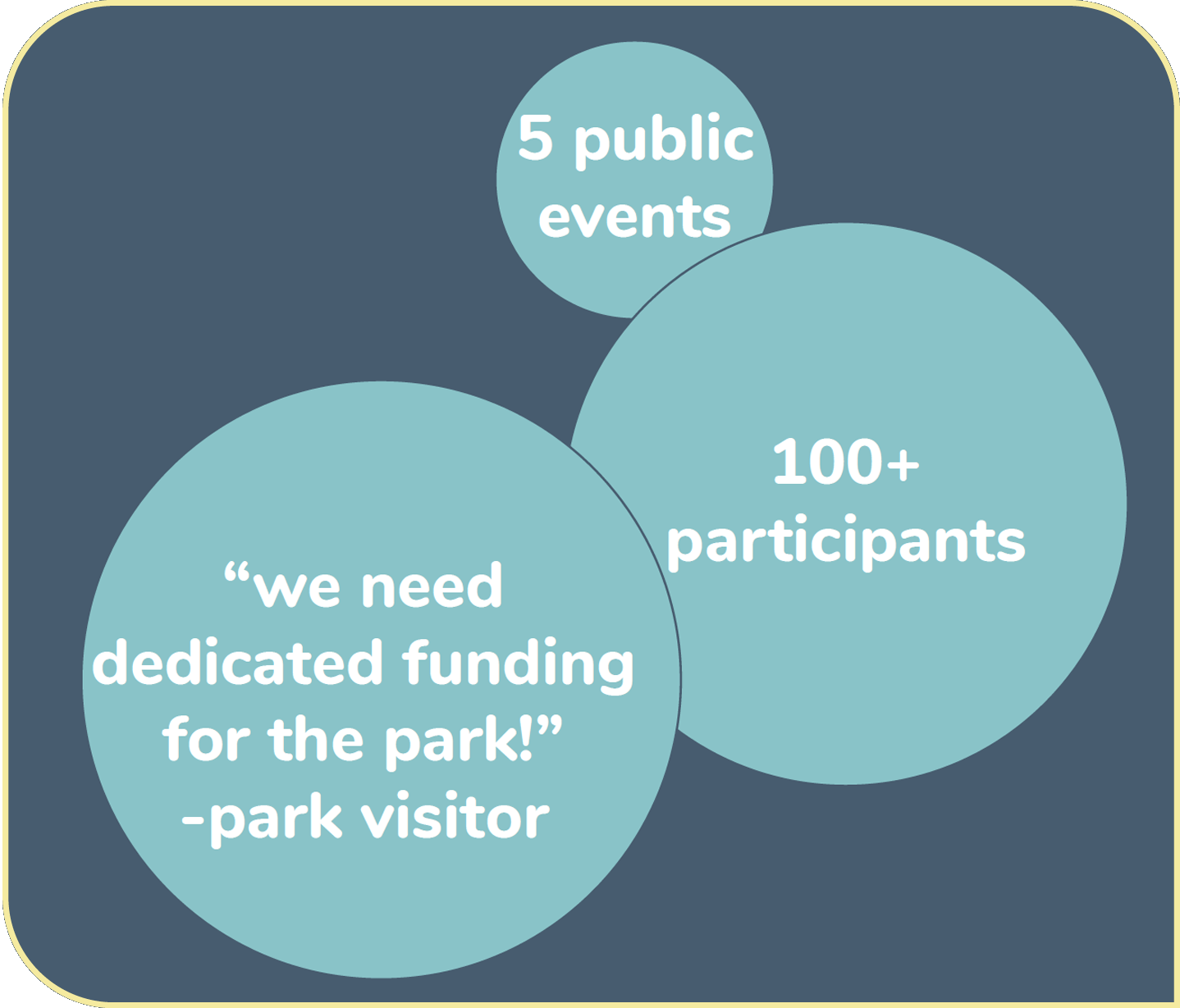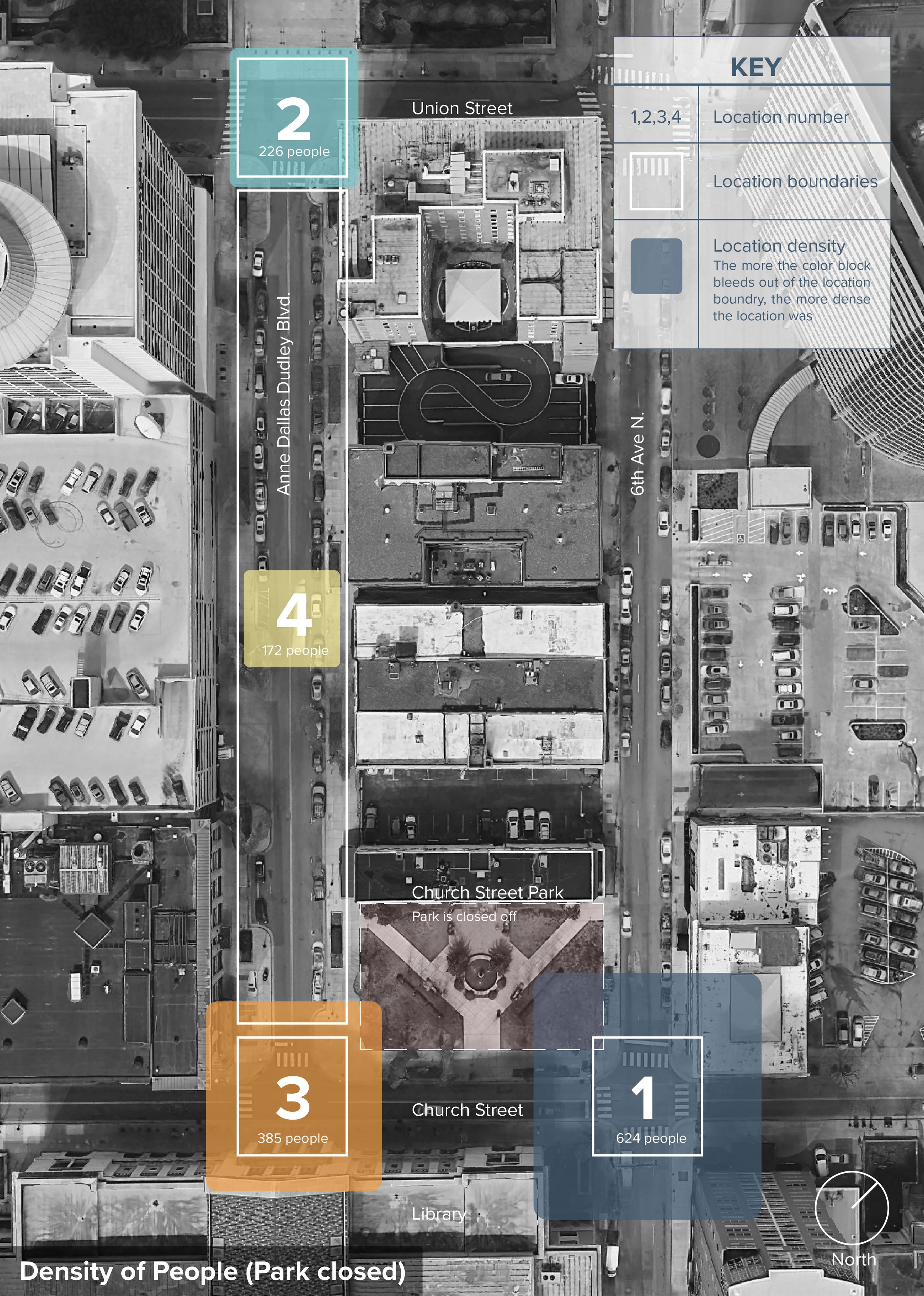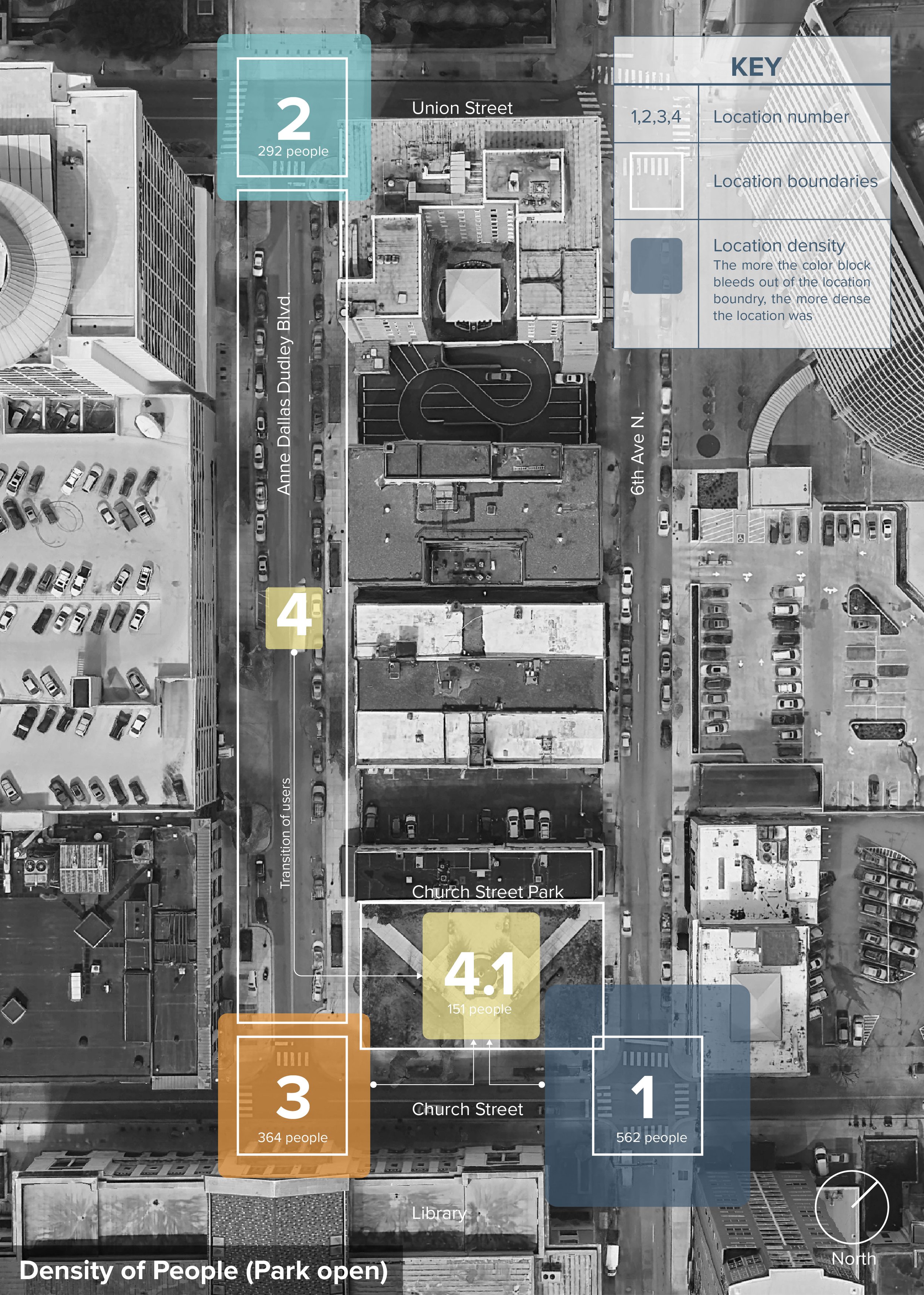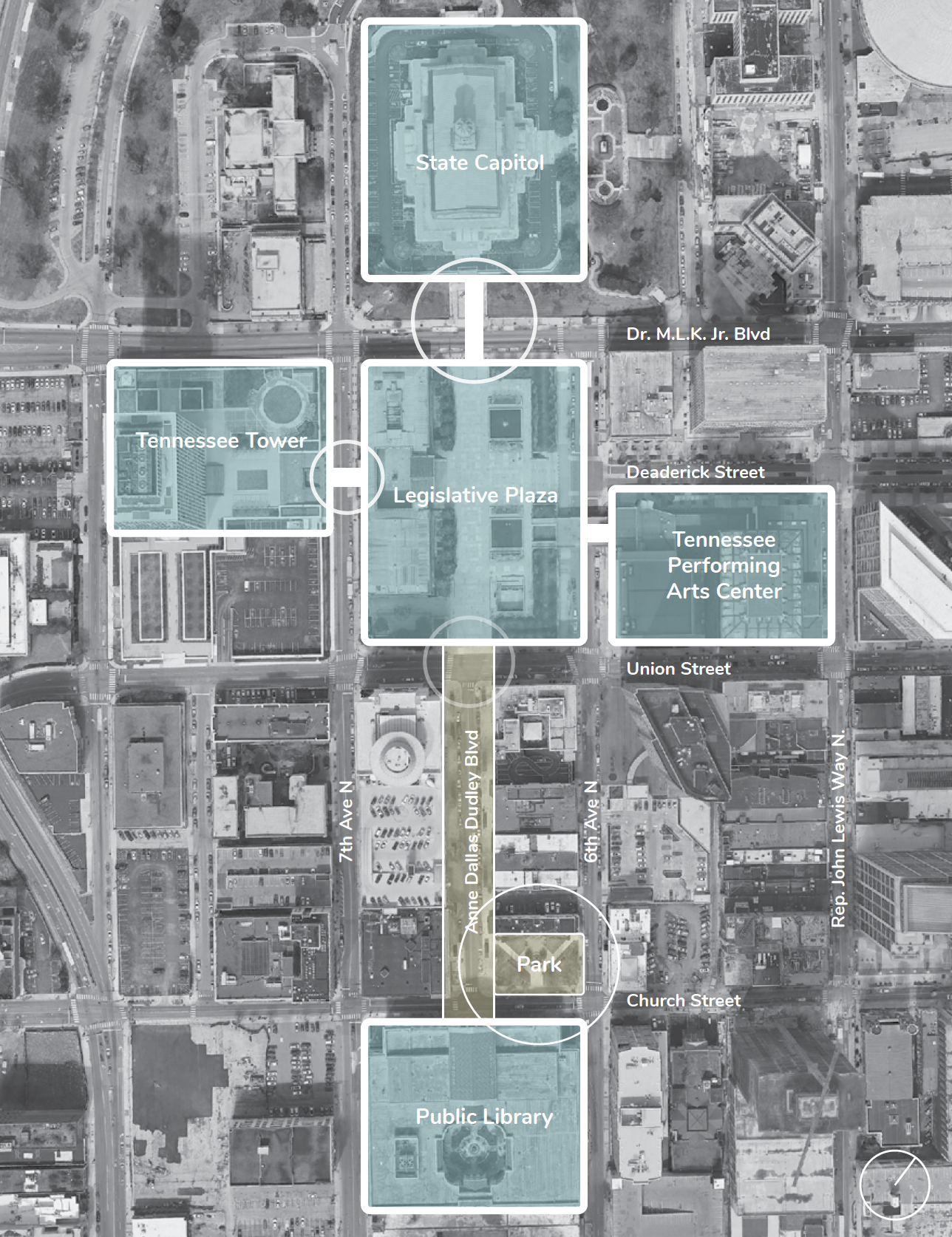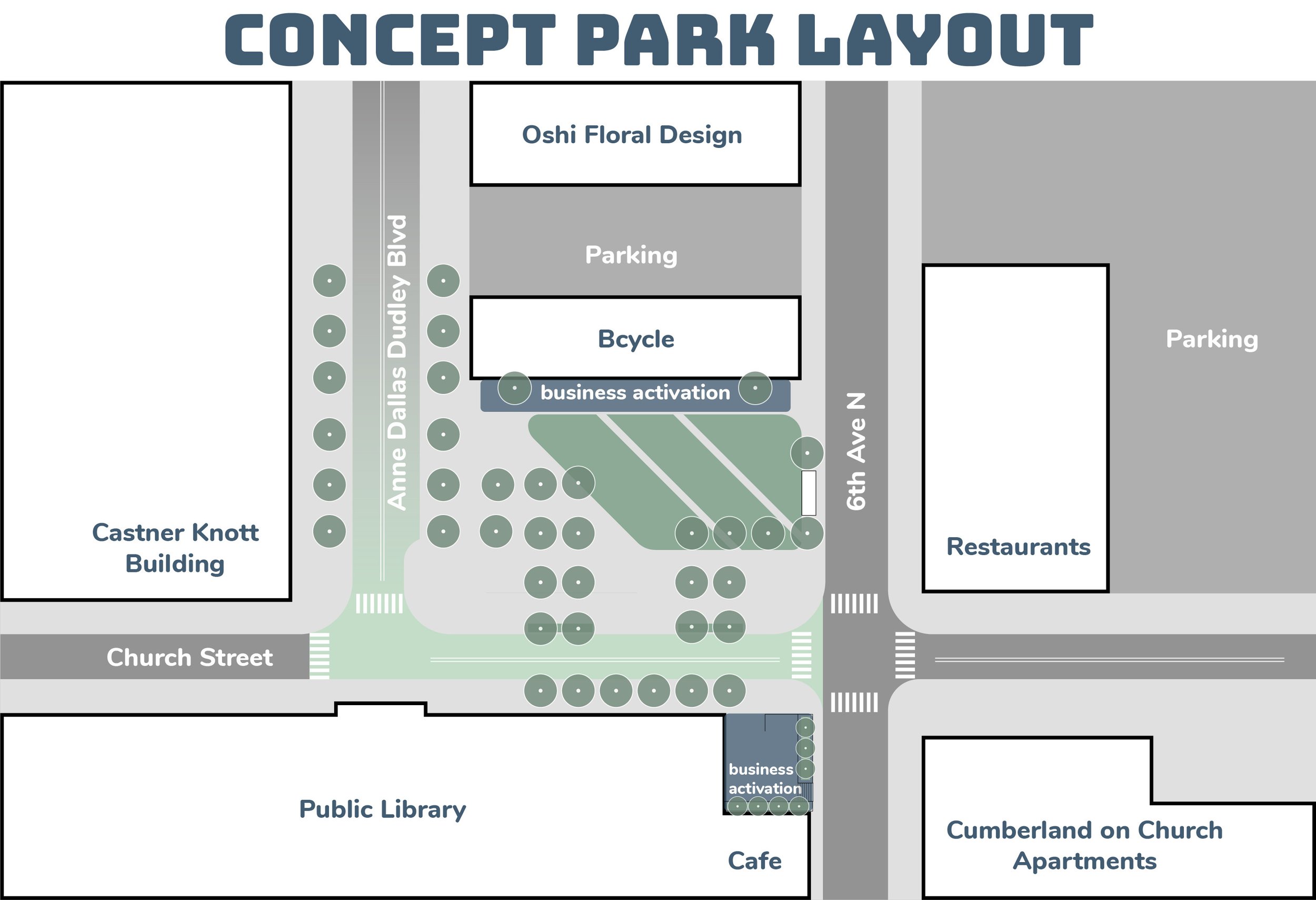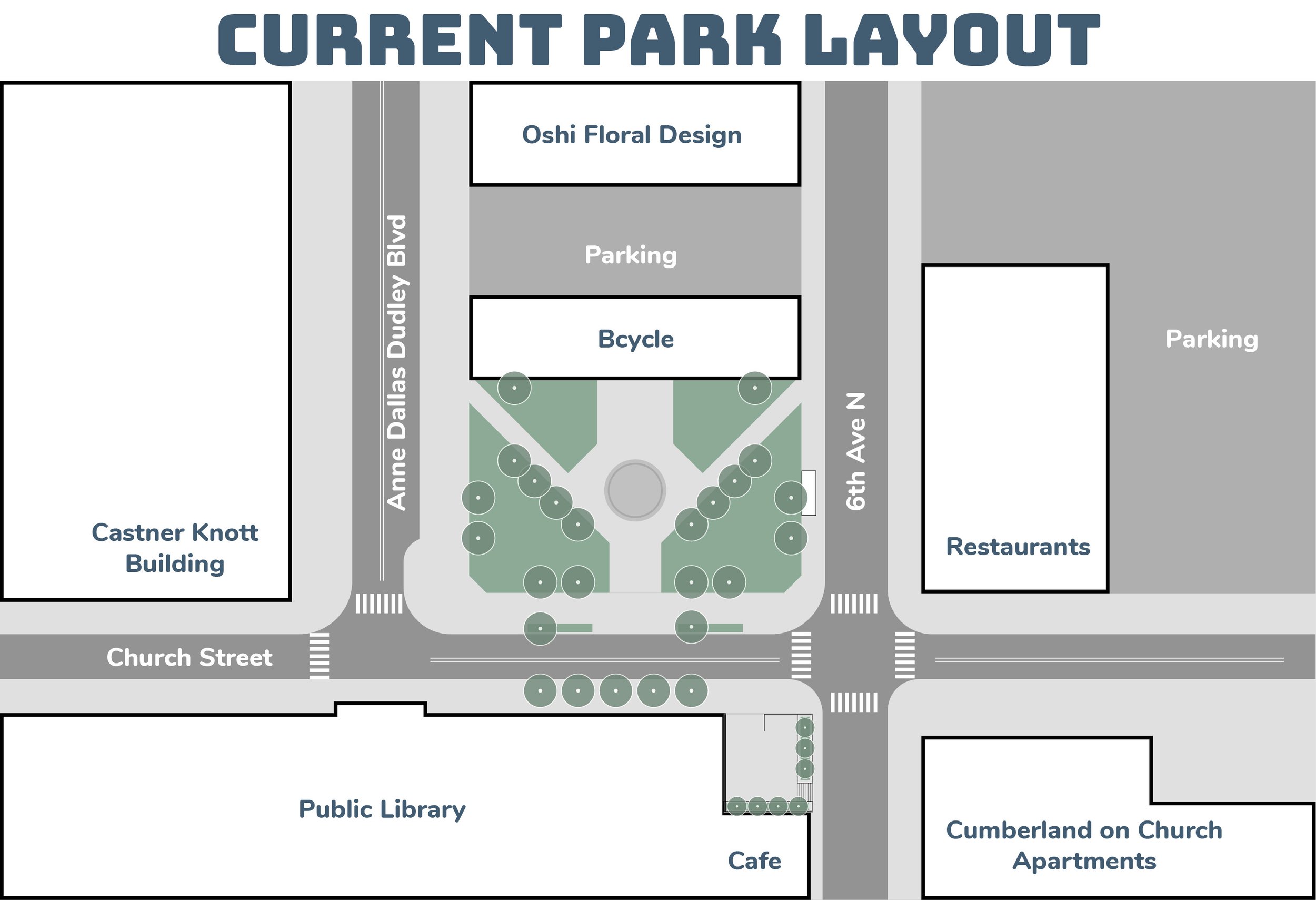Church Street Park - Now and Forever
By Veronica Foster, Remi Lynch, Joe Mayes, and Gretchen Trast
10 min read - This is a review of the past 6 months of activating Church Street Park with programs, and a synopsis of the community engagement to help visualize the future of the park.
Church Street Park: Project Overview
The Civic Design Center has demonstrated the reasoning and needs for a dynamically programmed and active Church Street Park – one that alters the status quo without forfeiting public spaces in doing so. Downtown open space is critical for the future success of Nashville. Accessible and exciting public spaces, located throughout our downtown, should be the hallmark of a thriving, healthy city. This central downtown public park is the chance to send a message that investing in public spaces matters to Nashville and carries the power to shape who we are, and who we wish to become. Through thoughtful programming – as exhibited over the summer, fall, and winter of 2021 – Church Street Park has shown itself to be a safe and successful public space that is a welcoming place for all. To maintain the success of this public space - active programming must be prioritized and funded through a diverse strategy of engaging both private and public funds.
City ContextChurch Street Park
Frankie Pierce Park
Riverfront Park West
Cumberland Park
Walk of Fame Park
Bicentennial Park
Anne Dallas Dudley Blvd
Womens Way
Printer’s Alley
Banker’s Alley
Ryman Alley
batman plaza
The Arcade
Frist Plaza
Nashville Yards
Public Library
War Memorial
Tennessee Tower
State Capitol
Schermerhorn Plaza
Public Square
On June 3rd, 2021, Church Street Park officially reopened to the public. The park was closed for renovations beginning of 2020 with an anticipated opening of a few months later. Due to the COVID-19 pandemic, plans for the park’s activation had to adjust. The park has a long history of being underutilized by the public, and was even threatened by a land swap in 2018 that would have shifted the park location to James Robertson Parkway and away from the residential core.
Presently, Church Street Park is the only green space in the central downtown area, and it is especially unique due to its small size. Riverfront Park, Frankie Pierce Park and Bicentennial Mall are other examples of green space downtown, but Church Street Park’s location in the heart of downtown Nashville provides the local community with a highly desirable gathering space.
The re-opening and intentional activation of Church Street Park has been long-awaited. The Civic Design Center has encouraged public debate around Church Street Park for many years, as shown in our blog posts "Dreaming Big for Public Space" — discussing what possibilities the space could give to future generations. The series features different iterations of what the space could be. Additionally, Church Street Park has also been a central node for PARK(ing) Day installations over the past several years allowing the public to imagine a vibrant, and more activated park Downtown.
Since its re-opening, there have been multiple events—the most prominent being the Historical Marker Event, “Campaign for the Vote '', that celebrated the location central in advocating for women’s suffrage. The Civic Design Center also hosted an Urban Design Form that featured information about the park transformation, and updates from the area’s representing Council Member as well as Metro Parks. This event was an opportunity to collect people's thoughts about the park as it exists. Alongside these one-time events, there have been daily activities, such as morning yoga, live music, and movie nights with great attendance by various demographics of people.
Church Street Park hosted 273 events and had over 7000 attendees in the Summer to Fall of 2021
Learning from Clarksville
On July 10th, 2021, the Civic Design Center and members visited Clarksville’s Downtown Commons as a precedent study for Church Street Park. This highly celebrated community space in the center of Clarksville’s historic downtown showed how a well programmed space can be successful and encourage a variety of users. The park features lawn games for all ages, historic identity markers, lush vegetation, public art and a water feature. The park also has areas for retail and food trucks, a public restroom, and shaded areas. Much like the trial programming for Church Street Park, Downtown Commons features a myriad of events, like Movie Nights, Farmer’s Markets and more! There were lots of exciting elements to take notes on, including designated staff to assist with programming.
Woman takes a photo of lush vegetation
Water feature at Clarksville Downtown Commons
Movie Night at Clarksville Downtown Commons
The Community Thinks Park Programming should stay
Through public events, informal surveys, and digital surveys, the Civic Design Center gathered public feedback on Church Street Park and encountered over 100 park visitors. The feedback highlighted the success of the programming efforts with the community’s main concern being continued funding for the programs.
During the first 6 weeks of activation, the Civic Design Center posted a survey to get feedback on how the space compared to the park before the implementation of programming. The feedback was overwhelmingly positive and called for continued active programming. A large percentage of the responses were from individuals 35+, as well as people who visit the park at least once a week.
Overall, the programming and changes to Church Street Park have been viewed as an improvement to how the park functioned before the existence of reoccurring programming. Respondents liked live music, fitness classes, historical events, art classes, and movies the most. Many would like to see these programs continue in the future. Some suggestions and improvements noted by respondents were to include hammock stands, bring additional food trucks, add public restrooms, and, most importantly, continue the programming! Many respondents are concerned the activity will decrease as time goes on, and that will lead to similar issues the park was experiencing prior to the programs, such as public substance use, lack of sanitation, maintenance, and security issues within the space.
Public Life Study of church Street Park
Photo of data record sheet from the Public Life Study, featuring many periods without cyclists, which our Design Fellow marked as “sad.”
The Design Center also conducted a study evaluating the pedestrian flow and use of space near Church Street Park. The study showed that more people used the park instead of the street to walk through the space. In addition to the increased pedestrian traffic throughout the park, the study showed that people were more comfortable walking to the park and using the space during lunch hours to either enjoy the programs, or the seating and shade during their mid-day meals. The study compared two days, one while the park was temporally closed for park improvements and the other on a week day shortly after the park was reopened.
This map comparison shows where activity is most dense when the park was closed (enclosed by temporary fences) vs when the park was open.
This graph shows the amounts of people surveyed from various locations that were highlighted on the Density of People Map.
Visioning flow Improvements
After observing the park and analyzing the results of the survey and study, the Design Center views the activation of Church Street Park as a significant improvement to the past conditions and the ideal situation for the long-term future of the space. With continued public input, the future of the park’s programs and activities should be adapted based on the community's needs, and the design can potentially be modified over time to enhance programming even more.
Park ContextBy highlighting the major context in the area surrounding the park, the current connection system that is in place, but not being fully utilized. The Legislative Plaza acts as the core for connecting major civic moments with the library being an anchor for that system. The connection through Anne Dallas Dudley Blvd has lost its impact on this connection system and leaves the library feeling separated from the rest. The park can be a catalyst to help promote the connection and enhance the site-lines from the Capitol to the library.
Emphasizing the adjacent civic axes around the park
Breaking down Church Street Park and its context can lead to better park flow and utilization of space. Currently, the park highlights entrances at the front center and in the back corners, but those locations do not directly reflect the flow of traffic to the park. The front corners are where the bulk of the pedestrian flow is coming from. Orienting the park towards the front corners can encourage a more logical flow into the park. By acknowledging and designing for Anne Dallas Dudley Blvd, the park can help to push the vision of creating that connection through the Blvd to the capitol.
The following images compare the existing park to a design concept based on the analysis and studies referenced in this article.
Current Park LayoutEntrance from the back corners and front
Formal layout with lots of segments
Layout doesn’t engage with its context
Concept Park LayoutOpen up the street to expand the park
Less segmented areas to expand the use
Activate the façade of the park with businesses
Other PARK DESIGN PRECEDENTS
What will it take to fund in the long term?
Comparing a few local parks, with programming levels desired for Church Street Park:
Clarksville, TN
When looking at other parks that have great programming, Clarksville’s Downtown Commons is a key example of how to formally program a space. In order to continue programming, financial commitment to the park is critical to sustain the vibrance and success of the park.
Here are the projected park expenses:
$50,000 - Cleaning and Regular Event Services, including yard games, movie nights, etc.
$100,000 - Concerts
$60,000 - Operations and Maintenance
$9,518 - Other
$219,518 - Total 2021 Programming Budget
Chattanooga, TN
Another great park to look to in terms of size and programming is Miller Plaza. Miller Plaza is an approximately ¾ acre park in the heart of downtown Chattanooga, designed by Koetter Kim & Associates, and completed in 1988. It is privately owned by River City Company and operated as a public park (as required from the original philanthropic/foundation funding). There is a 3,600 sf heated but not airconditioned pavilion on the western side and is open on weekdays, provided with tables and chairs, and mostly used around the lunch hour. There is a covered stage integrated into the building, which is donated for the free summer Friday night concert series Nightfall, by other groups. There are commercial lease spaces on either side of the stage, currently occupied by three restaurants. The upper level of the building houses two “green rooms” (above the stage) with a lounge, restrooms, and offices.
Here is an estimate of the park expenses:
$75,000 - Salary & Benefits (Some of these costs are offset by leasing spaces on or near the plaza and rentals of the plaza)
$35,000 - Care and Maintenance
$8,000 - Insurance
$13,500 - Utilities
$131,500 - Total Plaza Expenses














